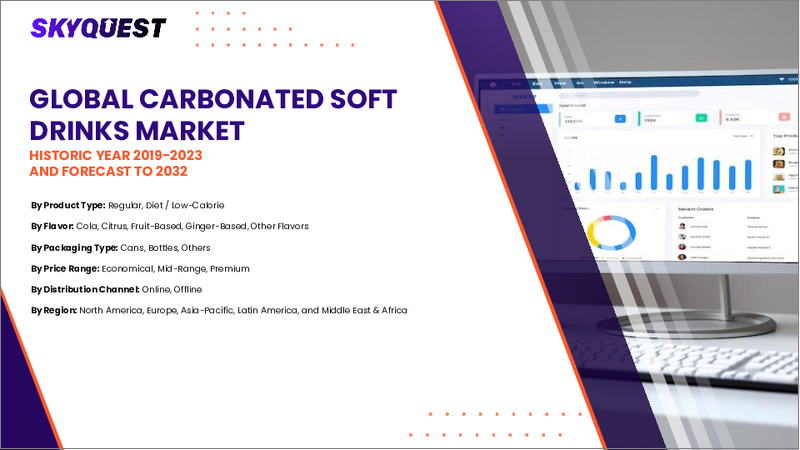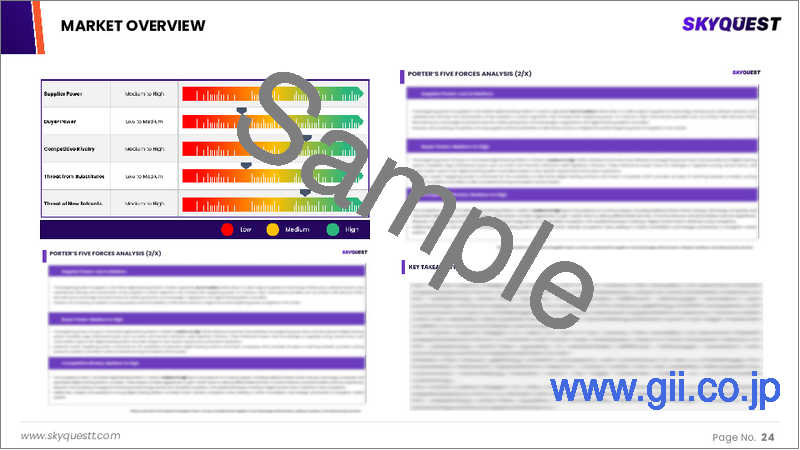|
|
市場調査レポート
商品コード
1663170
炭酸飲料市場規模、シェア、成長分析:フレーバー別、タイプ別、流通チャネル別、地域別 - 産業予測 2025~2032年Carbonated Soft Drinks Market Size, Share, and Growth Analysis, By Flavor (Cola, Lime), By Type (Bottles, Cans), By Distribution Channel, By Region - Industry Forecast 2025-2032 |
||||||
|
|||||||
| 炭酸飲料市場規模、シェア、成長分析:フレーバー別、タイプ別、流通チャネル別、地域別 - 産業予測 2025~2032年 |
|
出版日: 2025年02月19日
発行: SkyQuest
ページ情報: 英文 260 Pages
納期: 3~5営業日
|
全表示
- 概要
- 目次
炭酸飲料2023年の市場規模は4,093億米ドルで、2024年の4,289億5,000万米ドルから2032年には6,241億6,000万米ドルに成長し、予測期間中(2025-2032年)のCAGRは4.8%で成長する見通しです。
市場の洞察によると、消費者の購買習慣は利便性を重視した、手に取りやすいものへと顕著に変化しており、大量購入への依存度が低下しています。この動向は、保存料を最小限に抑え、クリーンな素材を採用した、保存可能で環境に優しいパッケージの技術革新を加速させています。健康志向の高まりを受けて、各社はステビアなどの天然成分を配合した製品を改良し、健康志向の消費者を引きつけるために「ナチュラル」な美的感覚を反映したパッケージを作りつつあります。レディ・トゥ・ドリンク飲料分野は特にこの需要の恩恵を受けており、製品が有害な添加物を含まないことを保証しつつ、アクティブなライフスタイルに合わせた人目を引くパッケージを重視しています。特にレーザーパッケージングを中心とした技術の先進は、生産効率を高め、コストを削減し、炭酸飲料の小規模小売店や自動販売機での販売を容易にし、最終的に現代消費者の外出先での嗜好に応えています。
目次
イントロダクション
- 調査の目的
- 調査範囲
- 定義
調査手法
- 情報調達
- 二次と一次データの方法
- 市場規模予測
- 市場の前提条件と制限
エグゼクティブサマリー
- 世界市場の見通し
- 供給と需要の動向分析
- セグメント別機会分析
市場力学と見通し
- 市場概要
- 市場規模
- 市場力学
- 促進要因と機会
- 抑制要因と課題
- ポーターの分析
主な市場の考察
- 重要成功要因
- 競合の程度
- 主な投資機会
- 市場エコシステム
- 市場の魅力指数(2024年)
- PESTEL分析
- マクロ経済指標
- バリューチェーン分析
- 価格分析
炭酸飲料市場規模:フレーバー別& CAGR(2025-2032)
- 市場概要
- コーラ
- ライム
- レモン
- オレンジ
- その他
炭酸飲料市場規模:タイプ別& CAGR(2025-2032)
- 市場概要
- ボトル
- 缶
炭酸飲料市場規模:流通チャネル別& CAGR(2025-2032)
- 市場概要
- スーパーマーケットとハイパーマーケット
- コンビニエンスストア
- オンライン
炭酸飲料市場規模:地域別& CAGR(2025-2032)
- 北米
- 米国
- カナダ
- 欧州
- ドイツ
- スペイン
- フランス
- 英国
- イタリア
- その他欧州地域
- アジア太平洋地域
- 中国
- インド
- 日本
- 韓国
- その他アジア太平洋地域
- ラテンアメリカ
- ブラジル
- その他ラテンアメリカ地域
- 中東・アフリカ
- GCC諸国
- 南アフリカ
- その他中東・アフリカ
競合情報
- 上位5社の比較
- 主要企業の市場ポジショニング(2024年)
- 主な市場企業が採用した戦略
- 最近の市場動向
- 企業の市場シェア分析(2024年)
- 主要企業の企業プロファイル
- 企業の詳細
- 製品ポートフォリオ分析
- 企業のセグメント別シェア分析
- 収益の前年比比較(2022-2024)
主要企業プロファイル
- The Coca-Cola Company(United States)
- PepsiCo, Inc.(United States)
- Keurig Dr Pepper Inc.(United States)
- Monster Beverage Corporation(United States)
- Fomento Economico Mexicano, S.A.B. de C.V.(FEMSA)(Mexico)
- Arca Continental, S.A.B. de C.V.(Mexico)
- National Beverage Corp.(United States)
- Jones Soda Co.(United States)
- Suntory Beverage & Food Limited(Japan)
- Britvic plc(United Kingdom)
- Embotelladora Andina S.A.(Chile)
- Refresco Group B.V.(Netherlands)
- Lotte Chilsung Beverage Co., Ltd.(South Korea)
- Fraser and Neave, Limited(Singapore)
- Kofola CeskoSlovensko A.S.(Czech Republic)
結論と提言
Carbonated Soft Drinks Market size was valued at USD 409.3 billion in 2023 and is poised to grow from USD 428.95 billion in 2024 to USD 624.16 billion by 2032, growing at a CAGR of 4.8% during the forecast period (2025-2032).
Market insights reveal a notable shift in consumer purchasing habits towards convenience-driven, grab-and-go items, reducing reliance on bulk purchases. This trend has accelerated the innovation of shelf-stable, environmentally friendly packaging that minimizes preservatives and employs clean materials. In response to growing health consciousness, companies are reformulating products with natural ingredients, such as stevia, and crafting packaging that reflects a "natural" aesthetic to attract health-oriented consumers. The ready-to-drink beverage segment is particularly benefiting from this demand, emphasizing eye-catching packaging tailored for active lifestyles while ensuring products are free from harmful additives. Technological advancements, particularly in laser packaging, are enhancing production efficiency and reducing costs, facilitating the sale of carbonated soft drinks through small retail outlets and vending machines, ultimately catering to the modern consumer's on-the-go preferences.
Top-down and bottom-up approaches were used to estimate and validate the size of the Carbonated Soft Drinks market and to estimate the size of various other dependent submarkets. The research methodology used to estimate the market size includes the following details: The key players in the market were identified through secondary research, and their market shares in the respective regions were determined through primary and secondary research. This entire procedure includes the study of the annual and financial reports of the top market players and extensive interviews for key insights from industry leaders such as CEOs, VPs, directors, and marketing executives. All percentage shares split, and breakdowns were determined using secondary sources and verified through Primary sources. All possible parameters that affect the markets covered in this research study have been accounted for, viewed in extensive detail, verified through primary research, and analyzed to get the final quantitative and qualitative data.
Carbonated Soft Drinks Market Segments Analysis
Global Carbonated Soft Drinks Market is segmented by Flavor, Type, Distribution Channel and region. Based on Flavor, the market is segmented into Cola, Lime, Lemon, Orange and Others. Based on Type, the market is segmented into Bottles and Cans. Based on Distribution Channel, the market is segmented into Supermarkets & Hypermarkets, Convenience Stores and Online. Based on region, the market is segmented into North America, Europe, Asia Pacific, Latin America and Middle East & Africa.
Driver of the Carbonated Soft Drinks Market
Manufacturers of carbonated soft drinks are making a strategic choice by adopting natural methods, appealing to consumers seeking healthier alternatives. This initiative is designed to capture the interest of those who prefer convenient options, solidifying these beverages as quintessential "on-the-go drinks." The market's accessibility continues to enhance their popularity, indicating a sustained growth trajectory. Additionally, the ready-to-drink segment is gaining prominence due to its ability to effectively meet consumer preferences and their increasing desire for such products. Overall, these trends highlight a thriving market driven by health-conscious choices and the demand for convenience in beverage options.
Restraints in the Carbonated Soft Drinks Market
The Carbonated Soft Drinks market is experiencing constraints as consumers grow increasingly conscious of their health needs, leading to a growing preference for products with reduced sugar levels and enhanced stress-relief properties. Additionally, various awareness initiatives are educating the public about the potential health risks associated with these beverages, particularly concerning their adverse effects on bone health and the nervous system. Consequently, this shift in consumer behavior and increased scrutiny of the health implications associated with carbonated drinks are expected to limit market growth during the projected period. This trend indicates a significant challenge for the industry moving forward.
Market Trends of the Carbonated Soft Drinks Market
The Carbonated Soft Drinks market is experiencing a notable trend towards technological advancements that enhance production efficiency and product appeal. Innovations such as laser technology are replacing traditional inkjet methods for labeling and packaging, enabling manufacturers to deliver high-quality printing that is both durable and quick. This shift allows for more efficient production processes and ultimately lowers costs, making beverages more affordable for consumers. Additionally, these developments foster better connections along production lines, improving overall supply chain management. As a result, brands are able to offer enhanced products that resonate with increasingly quality-conscious consumers, driving sales and market growth.
Table of Contents
Introduction
- Objectives of the Study
- Scope of the Report
- Definitions
Research Methodology
- Information Procurement
- Secondary & Primary Data Methods
- Market Size Estimation
- Market Assumptions & Limitations
Executive Summary
- Global Market Outlook
- Supply & Demand Trend Analysis
- Segmental Opportunity Analysis
Market Dynamics & Outlook
- Market Overview
- Market Size
- Market Dynamics
- Drivers & Opportunities
- Restraints & Challenges
- Porters Analysis
- Competitive rivalry
- Threat of substitute
- Bargaining power of buyers
- Threat of new entrants
- Bargaining power of suppliers
Key Market Insights
- Key Success Factors
- Degree of Competition
- Top Investment Pockets
- Market Ecosystem
- Market Attractiveness Index, 2024
- PESTEL Analysis
- Macro-Economic Indicators
- Value Chain Analysis
- Pricing Analysis
Global Carbonated Soft Drinks Market Size by Flavor & CAGR (2025-2032)
- Market Overview
- Cola
- Lime
- Lemon
- Orange
- Others
Global Carbonated Soft Drinks Market Size by Type & CAGR (2025-2032)
- Market Overview
- Bottles
- Cans
Global Carbonated Soft Drinks Market Size by Distribution Channel & CAGR (2025-2032)
- Market Overview
- Supermarkets & Hypermarkets
- Convenience Stores
- Online
Global Carbonated Soft Drinks Market Size & CAGR (2025-2032)
- North America (Flavor, Type, Distribution Channel)
- US
- Canada
- Europe (Flavor, Type, Distribution Channel)
- Germany
- Spain
- France
- UK
- Italy
- Rest of Europe
- Asia Pacific (Flavor, Type, Distribution Channel)
- China
- India
- Japan
- South Korea
- Rest of Asia-Pacific
- Latin America (Flavor, Type, Distribution Channel)
- Brazil
- Rest of Latin America
- Middle East & Africa (Flavor, Type, Distribution Channel)
- GCC Countries
- South Africa
- Rest of Middle East & Africa
Competitive Intelligence
- Top 5 Player Comparison
- Market Positioning of Key Players, 2024
- Strategies Adopted by Key Market Players
- Recent Developments in the Market
- Company Market Share Analysis, 2024
- Company Profiles of All Key Players
- Company Details
- Product Portfolio Analysis
- Company's Segmental Share Analysis
- Revenue Y-O-Y Comparison (2022-2024)
Key Company Profiles
- The Coca-Cola Company (United States)
- Company Overview
- Business Segment Overview
- Financial Updates
- Key Developments
- PepsiCo, Inc. (United States)
- Company Overview
- Business Segment Overview
- Financial Updates
- Key Developments
- Keurig Dr Pepper Inc. (United States)
- Company Overview
- Business Segment Overview
- Financial Updates
- Key Developments
- Monster Beverage Corporation (United States)
- Company Overview
- Business Segment Overview
- Financial Updates
- Key Developments
- Fomento Economico Mexicano, S.A.B. de C.V. (FEMSA) (Mexico)
- Company Overview
- Business Segment Overview
- Financial Updates
- Key Developments
- Arca Continental, S.A.B. de C.V. (Mexico)
- Company Overview
- Business Segment Overview
- Financial Updates
- Key Developments
- National Beverage Corp. (United States)
- Company Overview
- Business Segment Overview
- Financial Updates
- Key Developments
- Jones Soda Co. (United States)
- Company Overview
- Business Segment Overview
- Financial Updates
- Key Developments
- Suntory Beverage & Food Limited (Japan)
- Company Overview
- Business Segment Overview
- Financial Updates
- Key Developments
- Britvic plc (United Kingdom)
- Company Overview
- Business Segment Overview
- Financial Updates
- Key Developments
- Embotelladora Andina S.A. (Chile)
- Company Overview
- Business Segment Overview
- Financial Updates
- Key Developments
- Refresco Group B.V. (Netherlands)
- Company Overview
- Business Segment Overview
- Financial Updates
- Key Developments
- Lotte Chilsung Beverage Co., Ltd. (South Korea)
- Company Overview
- Business Segment Overview
- Financial Updates
- Key Developments
- Fraser and Neave, Limited (Singapore)
- Company Overview
- Business Segment Overview
- Financial Updates
- Key Developments
- Kofola CeskoSlovensko A.S. (Czech Republic)
- Company Overview
- Business Segment Overview
- Financial Updates
- Key Developments





